
myCBSEguide App
Download the app to get CBSE Sample Papers 2024-25, NCERT Solutions (Revised), Most Important Questions, Previous Year Question Bank, Mock Tests, and Detailed Notes.
Install NowSample Paper of Science Class 9 – in PDF
The CBSE Class 9 Science Sample Paper 2024-25 is structured in a well-organized manner, following the official blueprint for the academic session. The sample paper is divided into Part A (Employability Skills) and Part B (Subject-Specific Skills), covering all important chapters prescribed in the Class 9 Science syllabus. Download CBSE Class 9 Science Sample Papers 2o25 with Solutions
Although CBSE does not issue model papers for class 9 yet these are always similar to class 10. So we have prepared Class 9 Science Sample Papers 2025 as per CBSE guidelines. You can download them as PDFs from the myCBSEguide app or our student dashboard.
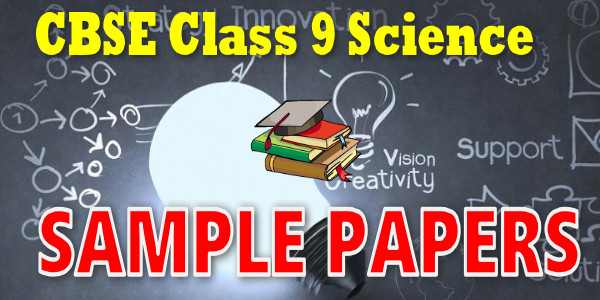
Sample Paper of class 9 Science – in PDF
CBSE has already released a new marking scheme and blueprint for Class 9. Based on that, we are providing Class 9 Science Sample Question Papers for the academic session 2024-25. These model question papers are available for free download on the myCBSEguide app and website in PDF format. This helps students to find the answer to the most repeatedly asked questions in CBSE board exams.
However, the new competency-based design is very dynamic students have to go deep into concepts to answer such questions. Class 9 Science involves practical questions too. So, you can’t mug up the theoretical part without understanding its practical implications.
A simple suggestion to students is that you must practice more and more full syllabus model papers to achieve your goals. Just install the myCBSEguide app and download the latest sample papers for class 9 Science today.
Sample Papers of Class 9 Science 2025 with solution
Class 9 Science Sample Papers 2024-25
We at myCBSEguide provide Class 9 Science Sample Papers for the session 2024-25 with solutions. These model question papers follow the course content given in NCERT textbooks and the CBSE curriculum. In class IX Science, schools conduct their annual examinations. So, it’s purely home exams in classes 9th and 11th. But still, the schools have to follow guidelines issued by CBSE and so as the format of the question paper.
Here is the annual exam question paper format of CBSE class 9 Science. It is exactly the same as CBSE provided for class 10 board exams.
Class 9 Science Sample Paper (2024-25)
Class 09 – Science
Sample Paper (2024-25)
Maximum Marks: 80
Time Allowed: : 3 hours
General Instructions:
- This question paper consists of 39 questions in 5 sections.
- All questions are compulsory. However, an internal choice is provided in some questions. A student is expected to attempt only one of these questions.
- Section A consists of 20 objective type questions carrying 1 mark each.
- Section B consists of 6 Very Short questions carrying 02 marks each. Answers to these questions should in the range of 30 to 50 words.
- Section C consists of 7 Short Answer type questions carrying 03 marks each. Answers to these questions should in the range of 50 to 80 words.
- Section D consists of 3 Long Answer type questions carrying 05 marks each. Answer to these questions should be in the range of 80 to 120 words.
- Section E consists of 3 source-based/case-based units of assessment of 04 marks each with sub-parts.
Class 9 Science Sample Paper Section A
- Following figure shows three states of matter and its interconversion. Which process display in A and B?
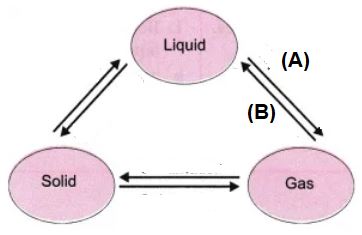 a) (A)Sublimation (B) condensationb) (A) Fusion (B) Solifificationc) (A) Vapourisation (B) Condensationd) (A) Fusion and (B) Condensation
a) (A)Sublimation (B) condensationb) (A) Fusion (B) Solifificationc) (A) Vapourisation (B) Condensationd) (A) Fusion and (B) Condensation - Which organelle is called the powerhouse of the cell?a) Golgi apparatusb) Ribosomesc) Plastidsd) Mitochondria
- If a body starts from rest, what can be said about the acceleration of the body?a) Uniform acceleratedb) Positively acceleratedc) Negative acceleratedd) Non-Uniform accelerated
- Find the incorrect pair
- Yellow revolution – pulse production
- Green revolution – grains production
- Blue revolution – fish production
- White revolution – milk production
a) (A)b) (C)c) (B)d) (D) - Which chemical is deposited on the cell wall of sclerenchyma?a) Pectinb) Cellulosec) All of thesed) Lignin
- Living cells were discovered bya) A.V. Leeuwenhoekb) Robert Brownc) Robert Hooked) R. Virchow
Boost Your Exam Preparation with the myCBSEguide App
To excel in your exams, download the app today! It provides comprehensive study materials for CBSE, NCERT, JEE (Main), NEET-UG, and NDA exams. With practice questions, sample papers, mock tests, and detailed solutions, you can study smarter and improve your performance.
For Teachers: Create Custom Exam Papers with Examin8
Teachers can use the Examin8 app to easily create and customize exam papers with their name, logo, and personalized content. This tool helps educators generate professional, curriculum-aligned assessments efficiently.
Start Your Journey to Success
Take the first step toward achieving better exam results. Download the myCBSEguide app or visit the myCBSEguide website and Examin8 website to access all the resources you need to start your preparation for success!
- How many atoms are present in {\text{P}}{{\text{O}}_{\text{4}}}^{ – {\text{3}}}ion?a) 5b) 1c) 4d) 3
- Which of the following sets includes simple permanent tissues?a) Collenchyma, parenchyma, Sclerenchymab) Pholem, xylem, collenchymac) Sclerenchyma, phloem, collenchymad) Parenchyma, phloem, sclerenchyma
- The water level in a measuring cylinder, before and after immersing a metal cube in it, is shown in the figure. The volume of the metal cube is:
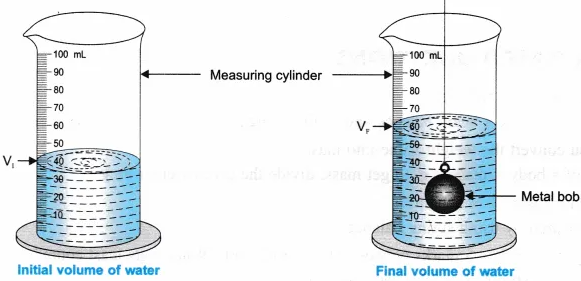 a) 18 cm3b) 24 cm3c) 20 cm3d) 22 cm3
a) 18 cm3b) 24 cm3c) 20 cm3d) 22 cm3 - The slope of distance-time graph gives instantaneous-a) distance covered.b) velocityc) accelerationd) speed
- An element has electronic configuration 2, 8, 4. It will be classified asa) Metalloidb) Noble gasc) Non-metald) Metal
- Fibrinogen is absent in _____.a) Both Serum and Plasmab) Serumc) Bloodd) Plasma
- A cell will swell up ifa) The concentration of water molecules in the surrounding medium is higher than water molecules concentration in the cell.b) The concentration of water molecules is the same in the cell and in the surrounding medium.c) The concentration of water molecules does not matter.d) The concentration of water molecules in the cell is higher than the concentration of water molecules is the surrounding medium.
- To prepare iron sulphide, by heating a mixture of iron filings and sulphur powder, we should use a:a) copper dishb) china dishc) watch glassd) petri dish
- Which of the following settles down when allowed to stand undisturbed doe sometimes?a) Copper sulphate solutionb) Bloodc) Muddy waterd) Solution of egg albumin in water
- Dietary requirement of protein increases:a) During studiesb) In the morningc) During sleepd) During lactation
- Assertion (A): A boy is enjoying a ride on a merry-go-round which is moving at a constant speed of 10 m/s. The boy is in uniform accelerated motion.
Reason (R): A body has a uniform acceleration if it travels in a straight line and its velocity first decreases then increases by equal amounts in equal intervals of time.a) Both A and R are true and R is the correct explanation of A.b) Both A and R are true but R is not the correct explanation of A.c) A is true but R is false.d) A is false but R is true. - Assertion (A): Gaseous state of ammonia is not regarded as vapours.
Reason (R): As the volume of a substance increases, its density increases.a) Both A and R are true and R is the correct explanation of A.b) Both A and R are true but R is not the correct explanation of A.c) A is true but R is false.d) A is false but R is true. - Assertion (A): The meristematic cells are compactly arranged and do not contain any intercellular space between them.
Reason (R): They contain few vacuoles or no vacuoles at all.a) Both A and R are true and R is the correct explanation of A.b) Both A and R are true but R is not the correct explanation of A.c) A is true but R is false.d) A is false but R is true. - Assertion (A): The valency of an element is defined as the number of electrons lost, gained, or shared by its atom during a chemical combination.
Reason (R): The outermost shell or orbit of an atom is known as the valence shell or valence orbit.a) Both A and R are true and R is the correct explanation of A.b) Both A and R are true but R is not the correct explanation of A.c) A is true but R is false.d) A is false but R is true.
Class 9 Science Sample Paper Section B
- Certain force acting on a 20 kg mass changes its velocity from 5 {ms}^{-1} to 2 {ms}^{-1}. Calculate the work done by the force.
OR
Calculate the work done in lifting 200 kg of a mass through a vertical distance of 6 m. Assume g = 10 m/s2.
- Why do the doctors advise to put strips of wet cloth on the forehead of a person having high fever?
- Why is the ceiling and wall behind the stage of good conference halls or concert halls made curved?
- What happens when the temperature of the solids increase?
- A horse continues to apply a force in order to move a cart with a constant speed. Explain why?
OR
A stone of 1 kg is thrown with a velocity of 20 ms-1 across the frozen surface of a lake and comes to rest after travelling a distance of 50 m. What is the force of friction between the stone and the ice?
- Name a species which has (i) one proton and one electron (ii) one proton and two electrons
Class 9 Science Sample Paper Section C
- Mention two practical applications of reflection of sound waves.
- Mention the conditions for an echo to be heard clearly.
- Composition of the nuclei of two atomic species X and Y are given as under:
X Y Protons 6 6 Neutrons 6 8 Give the mass numbers of X and Y. What is the relation between the two species?
- State which of the following situations are possible and give an example for each of these.
(a) An object moving with a constant acceleration but with zero velocity
(b) An object moving in a certain direction with an acceleration in the perpendicular direction.OR
The speed-time graph for a car is shown is Fig.

- Find how far does the car travel in the first 4 seconds? Shade the area on the graph that represents the distance travelled by the car during the period.
- Which part of the graph represents uniform motion of the car?
- On a railway station, a passenger hires a coolie to pick his luggage and carry it to the train. When the coolie finished his work, he asked for the money. But the passenger refused to pay him saying that he has done no work. Answer the following questions based on the above information:
- Was the passenger right in saying so?
- What values are not promoted by the passenger?
- Give a situation seen in everyday life when no work is said to be done by you even though you get tired.
To practice more questions & prepare well for exams, download myCBSEguide App. It provides complete study material for CBSE, NCERT, JEE (main), NEET-UG and NDA exams. Teachers can use Examin8 App to create similar papers with their own name and logo.
- A bullet travelling at 360 m/s strikes a block of soft wood. The mass of the bullet is 2.0 g. The bullet comes to rest after penetrating 10 cm into the wood.
a) Find the average de-accceleration force exerted by the wood.
b) Find the time taken by the bullet to come to rest. - Differentiate between plant cell and animal cell.
OR
Differentiate between rough and smooth endoplasmic reticulum. How is the endoplasmic reticulum important for membrane biogenesis?
- Draw well-labeled diagrams of various types of muscles found in the human body.
Class 9 Science Sample Paper Section D
- The weight of any person on the moon is about 1/6 times that on the earth. He can lift a mass of 15 kg on the earth. What will be the maximum mass, which can be lifted by the same force applied by the person on the moon?
OR
From a cliff of 49 m high, a man drops a stone. One second later, he throws another stone. They both hit the ground at the same time. Find out the speed with which he threw the second stone.
- State what will happen when human red blood cells are placed in a hypotonic salt/sugar solution.
- Why plant cell shrinks when kept in a hypertonic solution.
- Why lysosomes are known as suicidal bags?
- Explain what happens when a beam of light is passed through a colloidal solution.
- Why does the solution of sodium chloride does not show the Tyndall effect whereas the mixture of water and milk shows the Tyndall effect?
- Give two examples from daily life where the Tyndall effect is observed.
Class 9 Science Sample Paper Section E
- Read the text carefully and answer the questions:
A few layers of cells beneath the epidermis are generally simple permanent tissue. Parenchyma is the most common simple permanent tissue. It consists of relatively unspecialized cells with thin cell walls. They are living cells. Collenchyma allows bending of various parts of the plant-like tendrils and stems of climbers without breaking. Sclerenchyma tissue makes the plant hard and stiff. We have seen the husk of a coconut. It is made of sclerenchymatous tissue. They are long and narrow as the walls are thickened due to lignin. The tissue is present in stems, around vascular bundles, in the veins of leaves and in the hard covering of seeds and nuts.

- The flexibility in plants is due to which tissue?
- Is aerenchyma provides mechanical support?
OR
Is apical and intercalary meristems permanent tissue?
- Read the text carefully and answer the questions:
Irrigation – The process of supplying water to crop plants through human efforts by means of canals, wells, reservoirs, tube wells etc., is known as irrigation. Most agriculture in India is dependent on timely monsoons and sufficient rainfall spread through most of the growing season. However, the extra water required by crops is met through irrigation.
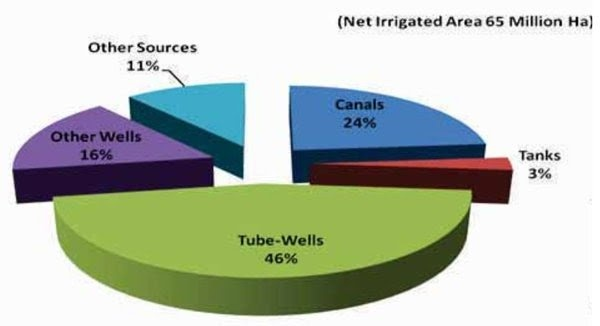
- Which is the most common source of irrigation?
- Mention the various sources of irrigation.
- Which is the least use source of irrigation?
OR
What are the other sources of irrigation?
- Read the text carefully and answer the questions:
Mixtures are constituted by more than one kind of pure form of matter. Sodium chloride is itself a pure substance matter. The solution is a homogeneous mixture of two or more substances. Lemonade, soda water etc. are all examples of solutions. Alloys are mixtures of two or more metals or a metal and a non-metal and cannot be separated into their components by physical methods. A solution has a solvent and a solute as its components. The component of the solution that dissolves the other component in it (usually the component present in a larger amount) is called the solvent. The component of the solution that is dissolved in the solvent
(usually present in lesser quantity) is called the solute.
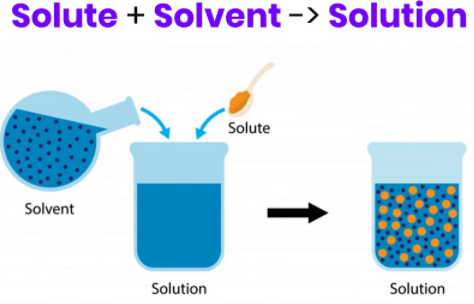
- In a water-sugar solution: Identify solute and solvent?
- What is the size of the particles of a solution?
- What is pure substance?
OR
What do you mean by Alloy?
Class 9 Science Sample Paper Solution
The syllabus of class 9 Science has no big changes in terms of content but the format has a few changes. You can find them easily in CBSE class 9 model papers for the academic session 2023-24. These model papers will surely help you prepare for your upcoming exams.
We have provided the solution to the sample question paper. You can find similar question papers with solutions on myCBSEguide app and website.
Class 9 Science Sample Paper Solution Section A
- (c) (A) Vapourisation (B) Condensation
Explanation: The correct figure is:
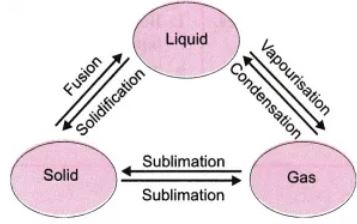
- (d) Mitochondria
Explanation: Mitochondria are called the powerhouses of the cell. The energy required for various chemical activities is released by mitochondria. They contain enzymes for cellular respiration. During cellular respiration, energy is released in the form of ATP (Adenosine triphosphate). The body uses energy stored in ATP. - (b) Positively accelerated
Explanation: If a body starts from rest, it starts moving. that means the change in velocity is positive. That means there is a POSITIVE acceleration. - (a) (A)
Explanation: Green revolution increases grain production (wheat). Blue revolution increased the fish production and the white revolution increased milk production in India. Yellow revolution is responsible for increasing oil production, not the pulse. - (d) Lignin
Explanation: The chemical deposited on the wall of sclerenchyma is lignin. This deposition of lignin on the wall makes these tissues impervious to water and air. - (a) A.V. Leeuwenhoek
Explanation: A.V. Leeuwenhoek in 1674 with the improved microscope, discovered free-living cells of algae Spirogyra in pond water for the first time.
To practice more questions & prepare well for exams, download myCBSEguide App. It provides complete study material for CBSE, NCERT, JEE (main), NEET-UG and NDA exams. Teachers can use Examin8 App to create similar papers with their own name and logo. - (a) 5
Explanation: There are 5 atoms in the phosphate ion, -1 atom of Phosphorus, and 4 atoms of Oxygen. - (a) Collenchyma, parenchyma, Sclerenchyma
Explanation: Two simple permanent tissue in plants are parenchyma and collenchyma while two complex permanent tissue in plants are xylem and phloem. Sclerenchyma tissue is dead simple permanent tissue of the plant. - (c) 20 cm3
Explanation: 60 – 40 = 20 cm3 - (d) speed
Explanation: The slope of a distance-time graph gives the instantaneous speed of the moving object. Instantaneous speed can be more or less than average speed. - (a) Metalloid
Explanation: There are some elements which have properties of metals and non-metal, such elements are known as Metalloids. Si have electronic configuration of 2, 8, 4.
Examples of Metalloids: Boron (B), Silicon (Si), Germanium (Ge), Arsenic (As), Antimony (Sb), Tellurium (Te), Polonium (Po), Astatine (At) etc. - (b) Serum
Explanation: Plasma is that part of the blood, which contains blood clotting agent called as fibrinogen, while serum is the fluid part of the blood and does not contain clotting agent (fibrinogen). The plasma and serum can be extracted from the centrifugation of blood. The serum is obtained after the clotting of blood, while plasma can be obtained before the coagulation of the blood. - (a) The concentration of water molecules in the surrounding medium is higher than water molecules concentration in the cell.
Explanation: A cell will swell up if it is placed in the hypotonic solution. This is so because the concentration of water molecules in the surrounding medium is higher than water molecules concentration in the cell So, the water molecules move from external solution into cell sap. - (b) china dish
Explanation: China’s dish is the right apparatus used for strong heating. So, china’s dish is used for heating as it has a high melting point and does not react with sulphur. - (c) Muddy water
Explanation: Muddy water will settle down because particles are heavy and settle due to gravity. Setting down of coarse particles under the influence of gravity is called sedimentation. During sedimentation, heavier particles settle down faster than finer particles. - (d) During lactation
Explanation: The dietary requirement of protein increases during lactation. Protein is called bodybuilding food. Protein is required in higher quantity during the lactation period after the parturition (the act of giving birth to young). Milk contains all the nutrients required for the growth of a baby. - (c) A is true but R is false.
Explanation: A body has a uniform acceleration if it travels in a straight line and its velocity increases by equal amounts in equal intervals of time. - (b) Both A and R are true but R is not the correct explanation of A.
Explanation: A substance which is liquid at room temperature, then its gaseous state is regarded as vapour. Ammonia is gas at room temperature , hence its gaseous state is not regarded as vapour. - (b) Both A and R are true but R is not the correct explanation of A.
Explanation: The characteristics of meristematic tissues include that the meristematic cells are compactly arranged and do not contain any intercellular space between them. They contain few vacuoles or no vacuoles at all. Hence, both the statements are true but the reason is not correct statement for the assertion. - (b) Both A and R are true but R is not the correct explanation of A.
Explanation: The valency of an element represents the combining capacity of the element. It can also be defined as the number of electrons lost, gained, or shared by its atom during a chemical combination. The outermost shell or orbit of an atom is known as the valence shell or valence orbit.
Class 9 Science Sample Paper Solution Section B
- Work done by the force = change in kinetic energy
= \frac{1}{2} \times m\left( {{v_1}^2-{v_2}^2} \right)
= \frac{1}{2} \times 20 \times \left( {{5^2} – {2^2}} \right)
= 210 JOR
Given, Mass, m = 200 kg, g = 10 m/s2 and Distance, h = 6 m
Work in lifting the mass is done against gravity.
Therefore, the work done is W = Force \timesDisplacement = mg \times h = mgh
W = mgh= 200 \times 10 \times 6 = 12000 J. - When a person has fever, his body temperature becomes more than the normal body temperature. If we put strips of wet cloth on the forehead of a person suffering from high fever, the water evaporates taking heat from the body. Thus, moist strips will lower his body temperature.
- Curved walls and celling of a concert hall work like concave reflecting surfaces. We know that a concave surface converges the reflected waves. This helps in ensuring that sound clearly reaches the audience.
- When temperature of the solid is increased, kinetic energy of the particles increases as results particles vibrates more freely with greater speed. They overcome the force of attraction between the particles and start moving more freely.
- When a cart is moving on the road, it has to encounter friction. To maintain a constant speed, some force need to be applied continuously to overcome the friction. Hence, the horse needs to continuously apply a force in order move the cart with a constant speed.
OR
Here,
Mass,m = 1 kg
Initial velocity,u = 20 ms-1
Final velocity,v = 0 ms-1
Distance travelled,S = 50 m
Force of friction, F =?
From the third equation of motion, we have, {\upsilon}^{2} = {u}^{2} + 2as
\Rightarrow \,\,\,a = \frac{{{\upsilon ^2} – {u^2}}}{{2s}} = \frac{{0 – {{(20\,m{s^{ – 1}})}^2}}}{{2 \times 50\,m}}
= \frac{{ – 400{m^2}{s^{ – 2}}}}{{100\,m}} = – 4\,m{s^{-2}}
From Newton’s second law of motion, we have
F = ma = 1kg \times (-4 {ms}^{-2}) = -4 kg {ms}^{-2} = -4 N
Negative sign indicates the force is acting opposite to the direction of motion.
Thus,the force of friction between the stone and ice is -4 N - Protium {}_1^1H
an isotope of hydrogen has 1 electron, one proton and no neutron.
Hydride ion (H–) has one proton and two electrons.
Class 9 Science Sample Paper Solution Section C
- Two practical applications of reflection of sound waves are as follows:
- Megaphone or speaking tube: A horn-shaped metal tubes, commonly called mega-phone. In this device, the sound energy is prevented from spreading out by successive reflection from the horn-shaped tubes.
- Ear trumpet or hearing aid: It is a device which is used by the persons who are hard of hearing. Its shape like a trumpet. The narrow end of it is kept in the ear hole of the person, whereas the wider end faces the speaker. The waves received by the wider end are reflected into the narrow end, which increases the sound energy and thus a person can hear clearly.
- Two conditions for an echo to be heard clearly are as follows:
- The minimum distance between the source of the sound and the reflecting body should be17 metres.
- The wavelength of sound should be less than the height of the reflecting body.
- Two practical applications of reflection of sound waves are as follows:
- The mass number of X = Number of protons + Number of neutrons = 6 + 6 = 12
The mass number of Y = Number of protons + Number of neutrons = 6 + 8 = 14
Since the number of protons (6) in the two species is the same and the atomic mass of the two species is different (12 and 14), the given atomic species are isotopes of the same element (with atomic number Z = 6). - (a)An object with a constant acceleration can still have the zero velocity. For example an object which is at rest on the surface of earth will have zero velocity but still being acted upon by the gravitational force of earth with an acceleration of 9.81 ms-2 towards the center of earth. Hence when an object starts falling freely can have contant acceleration but with zero velocity.
(b)When an athlete moves with a velocity of constant magnitude along the circular path, the only change in his velocity is due to the change in the direction of motion. Here, the motion of the athlete moving along a circular path is, therefore, an example of an accelerated motion where acceleration is always perpendicular to direction of motion of an objectat a given instance. Hence, it is possible when an object moves in a circular path.OR

- Distance travelled by car in the 4 second
The area under the slope of the speed – time graph gives the distance travelled by an object.
In the given graph
56 full squares and 12 half squares come under the area slope for the time of 4 seconds.
Total number of squares = 56 + \frac{12}{2} = 62 squares
The total area of the squares will give the distance travelled by car in 4 seconds. on the time axis,
5 squares = 2 seconds, therefore 1 square = 2/5 seconds
on speed axis there are 3 squares = 2 m/s
therefore, area of one square = \frac{2}{5} s\times \frac{2}{3}s = 4/15 m
so area of 62 squares = \frac{4}{15}m \times 62 = 248/15 m = 16.53 m
Hence the car travels 16.53 m in the first 4 seconds. - The straight line part of graph, from point A to point B represents a uniform motion of car.
- The passenger was right in saying so according to the laws of physics. Since the direction of force is vertically up and displacement horizontal, no work is said to be done.
- Sympathy and value for other’s work.
- When you push a heavy boulder but are unable to displace it. (Any other situation)
- Distance travelled by car in the 4 second
- Initial velocity,u = 360 m/s
Final Velocity,v =0
Distance Travelled ,S = 10 cm = 0.1 m
Acceleration,a = ?
From third equation of motion, v^2=u^2+2as
\implies 0 = {\left( {360} \right)^2} + 2a\left( {0.1} \right)
\implies a = \frac{{ – 129600}}{2} = – 648000m/{s^2}
Now,
mass of the bullet,m= 2.0g = 0.002 kg
Force,F = ma
= 0.002 \times \left( { – 648000} \right)
=\,-1296\,N
\therefore The average de-accelerating force exerted by the wood =\,-1296\,N
(b)
From first equation of motion,v=u+at
\implies 0= 360 + (-648000)t
\implies t = 5.56 \times {10^{ – 4}}s
Therefore,time taken by the bullet to come to rest = 5.56 \times {10^{ – 4}}s Plant Cell Animal Cell Cells comparatively larger in size Cells usually small in size Cell wall present Cell wall absent Plastids present Plastids absent Vacuole are large and generally one Vacuales are absent, if present small in size and large in number Dictyosmoes (Golgi apparatus) are present Prominent Golgi apparatus are present OR
Rough Endoplasmic Reticulum Smooth Endoplasmic Reticulum Ribosomes are present on the surface. Ribosomes are absent. Involved in the synthesis of protein. Involved in the synthesis of fat and lipid. ER makes lipid and protein which are the two important constituents of the plasma membrane. The biogenesis of the plasma membrane is dependent on the endoplasmic reticulum.
- The three main types of muscular tissues found in the human body are:
- Skeletal (striated) muscle tissue
- Smooth (Non-striated) muscle tissue
- Cardiac muscle tissue.
The well-labelled diagrams of these tissues are as follows:
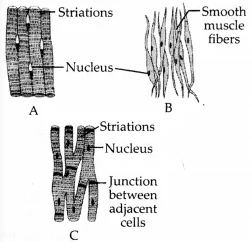
- Skeletal muscle tissue.
- Smooth muscle tissue
- Cardiac muscle tissue
Supercharge Your Exam Preparation with the myCBSEguide App
Want to boost your exam scores? Download the myCBSEguide app today! Get access to complete study materials for CBSE, NCERT, JEE (Main), NEET-UG, and NDA exams. The app offers practice questions, sample papers, mock tests, and detailed solutions to help you study efficiently and perform at your best.
For Teachers: Create Customized Exam Papers with Examin8
Teachers can also leverage the Examin8 app to create and customize their own exam papers with personalized branding, name, and logo. This tool allows educators to design professional, tailored assessments that align with their curriculum.
Take the First Step Toward Academic Success
Download the app or visit myCBSEguide website and Examin8 website to access valuable resources and get started on your path to exam success today! This helps you practice more effectively and prepares you for exam success. Download the app today or visit the dashboard to get started with comprehensive study resources, including sample papers, previous year questions, and subject-wise solutions student dashboard.
Class 9 Science Sample Paper Solution Section D
- Since the weight of any person on the moon is about 1/6 times that on the earth, hence acceleration due to gravity at the moon is 1/6 of that on earth. This means that by applying the same force a person can lift six times heavier objects on the moon than what he could lift on the earth. So, the maximum mass which can be lifted by the same force applied by the person on the moon is 6 \times 15 kg = 90 kg.
OR
For the first stone :
Initial velocity, u = 0 ms-1, Height of cliff, h = 49 m, g= 9.8m/s2
As we know, S = ut +\frac{1}{2}at2.
We, have, h = ut + \frac{1}{2}gt2
\therefore49 = 0 \times t + \frac{1}{2}\times 9.8 \timest2
\Rightarrowt2 = \frac{9.8}{9.8} = 10
\Rightarrowt = \sqrt{10} = 3.16 s
i.e., first stone would take 3.16 s to reach the ground.
For the second stone:
The time taken by the second stone to reach the ground is one second less than that taken by the first stone as both the stones reach the ground from the same height, h= 49m.
That is, for the second stone, time, t = (3.16 – 1) s = 2.16 s
\thereforeFor the second stone,
g = 9.8 ms-2, h = 49 m, t = 2.16 s, u = ?
Using, S = ut +\frac{1}{2}at2.
We have, h = ut + \frac{1}{2} gt2
\Rightarrow 49 = u \times 2.16 + \frac{1}{2}\times9.8 \times(2.16)2
\Rightarrow 49 – 22.86 = 2.16u or 26.14 = 2.16u
\Rightarrow u = \frac{26.14}{2.16} = 12.1 ms-1
Therefore, the speed with which he threw the second stone = 12.1 ms-1- When human red blood cells are placed in hypotonic salt/sugar solution they swell due to endosmosis.
- Plant cell shrinks when kept in hypertonic solution because the concentration of the solvent is more inside the cell. It shrinks due to exosmosis.
- Lysosomes are known as suicidal bags because, during the breakdown of cell structure, lysosome bursts and enzymes eat up their own cells.
- When a beam of light is passed through a colloidal solution, its path becomes visible due to the scattering of light by colloidal particles. This is called the Tyndall effect.
- Sodium chloride forms a true solution in water and the particle size of sodium chloride is small and does not scatter light whereas milk and water form a colloidal solution that scatters light and thus shows Tyndall effect.
- Examples of Tyndall effect are as follows:
- The Tyndall effect can be observed when sunlight passes through the canopy of a dense forest. In the forest, the mist contains tiny droplets of water which act as colloidal particles dispersed in the air.
- The Tyndall effect can be observed when a fine beam of light passes through a small hole in a dark room. This effect occurs due to the scattering of light by particles of dust or smoke present in the air.
Class 9 Science Sample Paper Solution Section E
- Collenchyma.
- No, aerenchyma helps aquatic plants to float. OR No, apical and intercalary meristems are not permanent tissue.
- The most common source of irrigation is tube wells. Irrigation is the artificial process of applying controlled amounts of water to land to assist in the production of crops.
- The various sources of irrigation are canals, tanks, tube wells, other wells, and other sources like rainwater harvesting.
- The last source of irrigation tanks. OR The other sources include rainwater harvesting and watershed management.
- Water is solvent and sugar is solute.
- 1 nm in diameter
- Pure substances are substances that are made up of only one kind of particle and have a fixed or constant structure. ORThe meaning of the term ‘alloy’ is a substance formed from the combination of two or more metals. Alloys can also be formed from combinations of metals and other elements. ex- steel.
Sample Papers for Class 9 2025
Supercharge Your Exam Preparation with the myCBSEguide App
Want to boost your exam scores? Download the myCBSEguide app today! Get access to complete study materials for CBSE, NCERT, JEE (Main), NEET-UG, and NDA exams. The app offers practice questions, sample papers, mock tests, and detailed solutions to help you study efficiently and perform at your best.
For Teachers: Create Customized Exam Papers with Examin8
Teachers can also leverage the Examin8 app to create and customize their own exam papers with personalized branding, name, and logo. This tool allows educators to design professional, tailored assessments that align with their curriculum.
Take the First Step Toward Academic Success
Don’t wait—take control of your exam preparation now. Download the app or visit myCBSEguide website and Examin8 website to access valuable resources and get started on your path to exam success today!
With the myCBSEguide app, you can access complete CBSE question papers along with detailed solutions for Class 10 and Class 12 students. This helps you practice more effectively and prepares you for exam success. Download the app today or visit the dashboard to get started with comprehensive study resources, including sample papers, previous year questions, and subject-wise solutions student dashboard.

Test Generator
Create question paper PDF and online tests with your own name & logo in minutes.
Create Now
myCBSEguide
Question Bank, Mock Tests, Exam Papers, NCERT Solutions, Sample Papers, Notes
Install Now